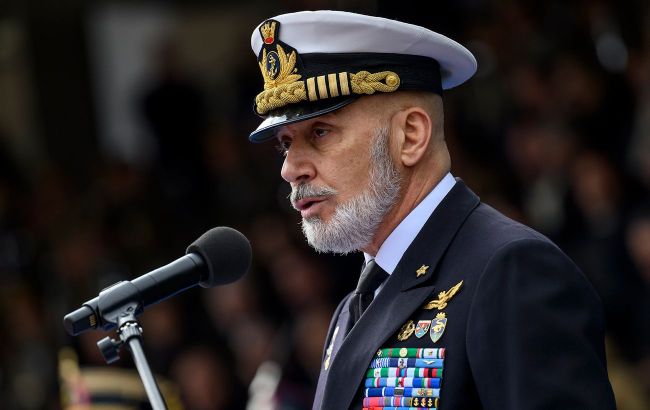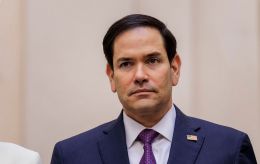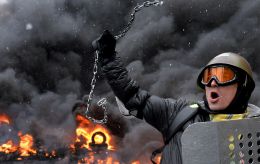NATO Military Committee Chair Adm. Cavo Dragone: 'Bad peace could be worse than no peace at all'
 Chair of the NATO Military Committee Admiral Giuseppe Cavo Dragone (Photo: Getty Images)
Chair of the NATO Military Committee Admiral Giuseppe Cavo Dragone (Photo: Getty Images)
Prospects of a truce and peace negotiations, threats to NATO from Russia, the role of the US in the Alliance, the deployment of European troops in Ukraine, and Ukraine's NATO membership prospects and other issues are discussed in an interview with the Chair of the NATO Military Committee, Admiral Giuseppe Cavo Dragone.
The North Atlantic Alliance is going through challenging times with Donald Trump coming to power. On one hand, the American president is making seemingly reasonable demands - European member states must spend more on their defense, as the current level of expenditure is insufficient. On the other hand, numerous signals from across the ocean suggest that Europe's security is primarily Europe's concern, and Europeans can no longer blindly rely on the US as their key ally. Strengthening European defense is inherently a long-term effort, while the threat from Russia is already here and now.
Responding to RBC-Ukraine's questions, the Chair of the NATO Military Committee (the highest-ranking military official in the Alliance), Italian Admiral Giuseppe Cavo Dragone, said: "Thirty-two nations make up the Alliance, so it is normal to expect each one of them to deliver their share. In this sense, President Trump is correct that Europe needs to do more – and Europe is responding."
Beyond internal disagreements, the number one issue for NATO has been and remains Russia's aggression against Ukraine. "Russia remains the aggressor, whatever the reasons they claim are behind their actions," Dragone notes in response to a question about Russia's current demands for a ceasefire. He emphasizes that it is Moscow that must now prove its interest in a lasting peace.
At the same time, when directly asked whether Ukraine's NATO membership is still on the agenda, Dragone answers cautiously: "It was never agreed that whenever peace talks would start and then end, that this would definitely include NATO membership. As it now stands, NATO membership for Ukraine does not look like it is going to be part of the ongoing peace negotiations."
— According to US President Donald Trump, his actions "have made NATO much stronger." To what extent is this assessment correct, given that there are completely opposite assessments among European NATO members?
— I believe there are many relevant comments and assessments already on this subject. As you must have heard from different stakeholders directly involved in the security of the Euro-Atlantic region, non-US Allies need to increase their investment in defense spending and capabilities. The NATO Secretary General, Mr. Mark Rutte, has called upon Allied nations to increase their defense spending, as have many European leaders.
I believe that – at this point – no one would doubt the absolute necessity of non-US Allies needing to spend more for a stronger NATO, for two reasons. First of all, one of the core values of the Alliance is burden sharing, and for many years, the US has been covering most of the bill. Second, the current and foreseeable security scenario demands a stronger NATO.
Thirty-two nations make up the Alliance, so it is normal to expect each one of them to deliver their share. In this sense, President Trump is correct that Europe needs to do more – and Europe is responding. Defense spending across the Alliance is on an upward trajectory. We have gone from 3 Allies at 2% in 2014 to two-thirds in 2024, with more increases on the way.
These are the facts. A stronger Europe benefits America and makes NATO stronger. In a more dangerous and competitive world, NATO makes all of us safer.
— Could the potential idea of the United States to give up the role of NATO’s Supreme Allied Commander Europe, as reported by the US media, significantly weaken the Alliance? Is it true that the balance of power within the Alliance is already shifting significantly, given the passivity of the United States and the activation of Europe?
— I will not speculate on these reports. US officials have repeatedly made clear their commitment to the Alliance and to ensuring that NATO’s deterrence and defense remain robust.
What I will tell you is that the Alliance is crafted and fitted in such a way that, should one of its Allies need to or want to remodulate its contribution, the others would step in. There are measures to ensure NATO continues its mission to guarantee security. No matter what. Every decision in NATO has always been taken in coordination with all Allies. This is our strength, which has made this Alliance the most successful politico-military Alliance in history.

Admiral Dragone at a meeting with the Commander-in-Chief of the Armed Forces of Ukraine, Oleksandr Syrskyi (Photo: facebook.com/GeneralStaffua)
— Which country or countries are the main threats to NATO today? Do you think that a direct clash between Russia and NATO is possible in the coming years? Is NATO ready for such a conflict, and will it be ready at this hypothetical moment?
— As clearly stated in NATO’s Strategic Concept and NATO’s Military Strategy, Russia and Terrorist Groups are our main threats.
Regarding a possible clash, as a military man, I would tell you that, should Russia make such an unwise move, the response would be catastrophic for Moscow. No doubt, our forces and capabilities, as NATO, largely overwhelm Russia’s. Due to NATO’s deterrence and defensive posture, the possibility of a ‘clash’ with Russia is small, although not impossible. Our deterrence, therefore, must remain strong, and we must stay vigilant.
We have our defense plans in place. They are strong. We are ready. That is why there has been, for over 75 years, peace and stability in Allied nations.
— If Russia is not defeated in Ukraine and does not bear strict responsibility for its aggression, is there a risk of its attack on other European countries (the Baltic states, Moldova, Romania, Poland, etc.), as some European leaders regularly state?
— First of all, the Baltic States, Romania, and Poland are NATO Allies, so any aggression against these nations by Russia would be met with a response of thirty-two nations.
That said, since the 1990s, Russia has cyclically repeated itself, with aggressions and invasions of neighboring countries, often using hybrid, destabilization campaigns below the threshold of war. It is a pattern that is now well documented.
As I said, we must deter any possible ambition by Russia or any potential adversary to move against the Alliance. We must do this first through diplomacy, of course, but any talk shall be backed up by our posture of strength. That is the unique characteristic of NATO – the combination of both soft and hard power.
— How realistic is the withdrawal of some US troops from Europe, particularly from Eastern Europe, and how serious a threat does it pose?
— NATO has not seen any plans related to adjusting the US force posture in Europe.
On the other hand, in the last few days, the US Administration has repeatedly confirmed its commitment to NATO, the transatlantic relationship, and the European Allies. This is what really counts to me.
NATO has robust defense plans in place, and we are working to ensure we have the right forces and capabilities in place to deter and -if needed- defend each other. If at some time in the future, there will be movements of US troops around or out of Europe, what I am absolutely certain about is that everything will continue to be done in coordination, among all 32 Allies. Priority would be given to guaranteeing continuity in forces and capabilities disposition to ensure the same levels of security, defense, and deterrence we have benefitted from over 75 years.
— How effective a guarantee of post-war security for Ukraine can be the deployment of European troops on its territory, which is currently being actively discussed? In general, what specific security guarantees for Ukraine could make it impossible for Russia to repeat its aggression in the short, medium, and long term?
— A deployment of forces could be useful, I believe, but under very specific conditions.
First of all, a clear ceasefire that is respected by both sides. Then, a strong mandate, preferably under the aegis of the UN. Finally, a credible force, multinational and possibly not only of European forces, numerically capable of expressing a significant presence along the entire Russian-Ukrainian border.
The first guarantee of security will continue to be the Ukrainian Armed Forces who, in these three years of war, thanks to their tenacity and the support received, although immensely and constantly tested, have achieved and are consolidating extraordinary and admirable levels of efficiency.
Ukraine will continue to receive important support from several contributing countries in terms of supplies, training, and interoperability. This will allow it to rebuild what has been worn out by the war and reorganize its Armed Forces in order to provide all the necessary deterrence against potential new aggression.
What is needed post-war is for the peace to be durable — this cannot be Minsk 3. Russia must not use a ceasefire to regroup and must never again try to take one square inch of Ukrainian land. That is precisely why NATO Allies have been providing Ukraine with so much support. This matters for Ukraine’s security, but it is so much more than that. This is about security across Europe and around the world.

— Can we say that Ukraine’s membership in NATO is really “off the table”?
— The main priority right now - for everyone – is to reach a just, durable peace. At the Washington Summit last year, NATO committed to future NATO membership for Ukraine.
However, it was never agreed that whenever peace talks would start and then end, this would definitely include NATO membership. As it now stands, NATO membership for Ukraine does not look like it is going to be part of the specific, ongoing peace negotiations.
Nevertheless, in the future, should all the conditions be met, including Ukraine’s own interest and the full agreement by all Allies, we could not rule out the possibility that a process for stronger ties between Ukraine and NATO could be initiated.
— Italian Prime Minister Giorgia Meloni has put forward the idea of extending NATO’s Article 5 to Ukraine without Ukraine becoming a member of the Alliance. How do you feel about this idea? How realistic is it?
— It is our policy not to comment on Heads of State remarks. What I can tell you is that – even before Russia’s illegal and brutal war of aggression against Ukraine – NATO had been working closely with Ukraine to help them develop their defense, making it more effective and deterrent. We are doing it now, as we speak, thanks to our commands like NATO Security Assistance and Training for Ukraine (NSATU) and the Joint Analysis, Training and Education Center (JATEC).
We will continue this through training, advising, and cooperation programs to work closely with Ukraine. The best security guarantee will come with a stronger and even more resilient Ukraine defense now and into the future.
— In general, how would you assess the state and capabilities of the Ukrainian army? How close is it to NATO standards now?
— Since the 1990s, NATO and Ukraine have developed a strong partnership. Ukrainian Armed Forces personnel have contributed to NATO operations and missions for a number of years – training and working side by side with NATO Allies, becoming more interoperable.
Since 2016, as part of the Comprehensive Assistance Package, as well as several other action plans such as the Military Committee Ukraine Work Plan, NATO has been working with Ukraine to support its ability for its own security and to implement wide-ranging reforms based on NATO standards, Euro-Atlantic principles, and best practices.
During the conflict, Ukraine has demonstrated resilience and adaptability, proving it can integrate NATO weapons, tactics, and training effectively. While it may not yet fully meet NATO’s technical and structural standards, its battlefield performance, innovation, and leadership make it a highly capable force - one that NATO can work with closely in the future.
During my visit to Ukraine earlier this year, I saw this for myself, including how dedicated your Armed Forces are. They are inspirational, highly professional, determined, and hard-working. They are fighting daily for your way of life and your nation. They are also innovating on the field as this war combines both modern and traditional warfare. They are showing us how NATO standards may need to adapt in the future to keep pace with evolving threats.
— How would you assess the current state of affairs on the battlefield in Ukraine? How do you think the Russians managed to push Ukrainian forces out of a large part of the Kursk region, and how strategically important is this retreat for Ukraine?
— The situation on the ground remains very volatile. Russians continue to make small gains on the battlefield, but at a huge price in terms of human losses and without considering the rapid erosion of their arsenals.
However, as I said before, the spirit and courage of the Ukrainian Armed Forces are truly remarkable. Allies are doing their very best to support the totally legitimate right of Ukraine’s self-defense.

Admiral Dragone and President of Ukraine Volodymyr Zelenskyy (Photo: president.gov.ua)
— In the context of the ongoing peace talks, what concessions seem likely from both the Ukrainian and Russian sides?
— I believe we are still in a very early phase of peace negotiations, so I cannot comment on an ongoing process. Diplomacies are fully at work, 24/7.
What is key now is to bring this war to a just and lasting end as soon as possible. Of course, for Ukraine is extremely important to arrive at the table from a position of strength. This is why NATO continues to support Ukraine, awaiting developments from the negotiating tables.
This is not about fueling the war; it is about ensuring that Ukraine can defend itself today and in the future. The stronger Ukraine is, the greater the chances of getting a good deal for lasting peace. This is crucial not only for Ukraine’s security but for us all.
— Does Russia have the right to put forward any “conditions” for a ceasefire, as it is doing now?
— Russia remains the aggressor, whatever the reasons they claim are behind their actions. On top of that, Russia has historically and repeatedly not respected previous agreements.
This is why the utmost attention should be given to which conditions are put on the table. The Ukrainians have agreed to a ceasefire, so the ball remains in Russia’s court. It is up to Russia to respond and demonstrate that they are committed to lasting peace.
In the end, in any negotiation, part of the game is to propose, but also to refuse, any proposals by the other party.
— Will it be realistic to ensure a complete ceasefire along such a long front line as in Ukraine? If hostilities are frozen along the current contact line (as all negotiators are almost openly saying), will the Russian-Ukrainian war turn into a typical “frozen conflict”? How high will the risk of its “defrosting” be in the near future?
— Planning to ensure a lasting ceasefire is an extremely complex task, as it involves a huge number of factors.
Of course, we all wish for a complete ceasefire all over Ukraine as soon as possible, as well as a just and lasting peace! That said, as I have already stated, a bad peace could be worse than no peace at all.
A frozen conflict would be a worst-case scenario. Let us focus now on achieving and maintaining a rightful and long-lasting enduring peace. Slava Ukraina!

